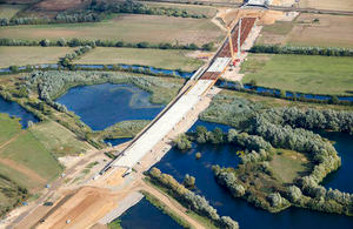Around 10% of the schemes on Highways England’s original 2015-2020 programme have been kicked into the long grass as they do not provide the necessary return on investment.
And around a third have been pushed back into the second Road Investment Strategy (RIS) period, 2020-2025.

A major scheme to upgrade the A14 is progressing
In the last year of RIS 1, chief executive Jim O’Sullivan hailed Highways England's achievements as a significant though perhaps not a complete a success.
Speaking at Traffex, he said: ‘Of the original 112 schemes, 29 have already been completed, 15 are in construction, 18 are expected to start this year and 37 now start in RIS 2. And 11 we revisited and the return on investment just wasn’t good enough.
‘And we have paused those perhaps for a future time when the traffic demand will make them more viable. This is being driven not just by our desire to have better roads but is has to be better for the stop using communities and the environment.’
The remaining two schemes can be accounted for by the reorganisation of the scope of projects, Transport Network understands.
The figures mark an increase in the number of schemes out on hold.
In 2017, when Highways England first announced that it would be restructuring the RIS, it said six schemes were being shelved to undergo further analysis to make them meet benefit cost ratio (BCR) targets and two schemes set to move into RIS 2.
Highways England has a BCR threshold of 1.5. If a scheme falls below this level Mr O'Sullivan must write to government with a view to the scheme being paused while the Government reevalutes it.
In terms of more minor schemes, Mr O’Sullivan said 45 more minor schemes as part of the original pinch point programme and they have removed 54 of the worst congestion and safety hotspots.
‘They are eliminating 134 million hours of delay every year.’
Mr O’Sullivan also celebrated the reduction in ‘accidents for our traffic officers by a factor of three and injuries to our road workers by about 30%’. In 2015 Highways England was launched through combining the Highways Agency – the strategic road network project delivery arm of the DfT - with the traffic officers service.
Looking back at the perspective he had at the start, Mr O’Sullivan said: ‘My success target at that time was that within three or four years it would be taken for granted that we would speak with authority about what should be in the RIS 2 and how challenging it should be.
‘By the outcomes as we measure them today our ambitions seem modest at the time. We are [now] considering the future of roads and the future of technology in roads. We are talking about the changes coming over the next 15 years and beyond. We are also seen to have safety, customer service and delivery deep in our DNA. We have established a reputation for listening.
‘To stakeholders we are seen as custodian of country’s roads and it is great to see the trickle out idea that if it is working for Highways England we should do it for major local roads and undoubtedly the Governments Major Roads Fund has been inspired by Highways England making a fist of the challenge they have been given.’
Register now for full access
Register just once to get unrestricted, real-time coverage of the issues and challenges facing UK transport and highways engineers.
Full website content includes the latest news, exclusive commentary from leading industry figures and detailed topical analysis of the highways, transportation, environment and place-shaping sectors.
Use the link below to register your details for full, free access.
Already a registered? Login